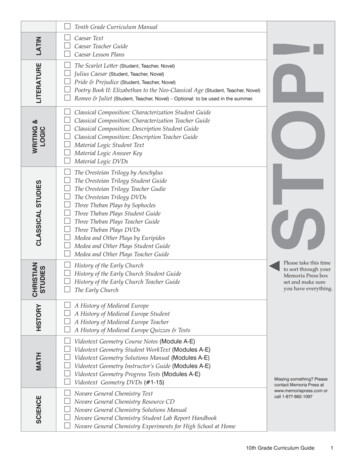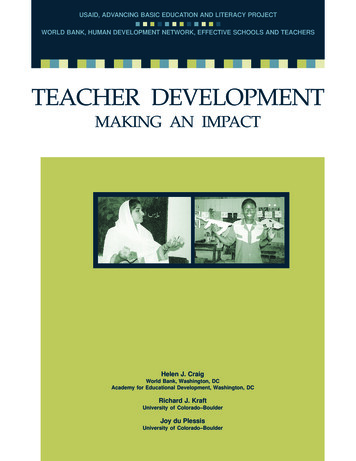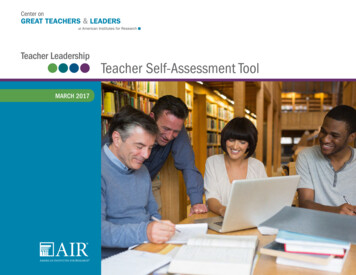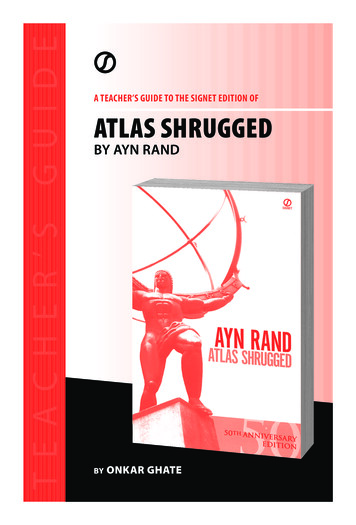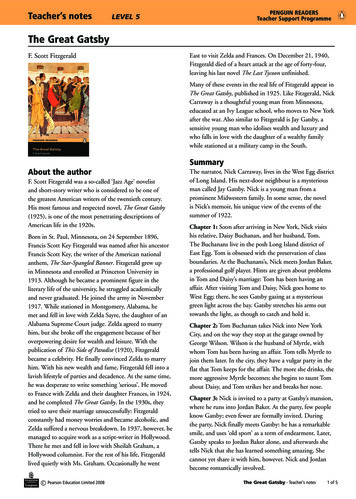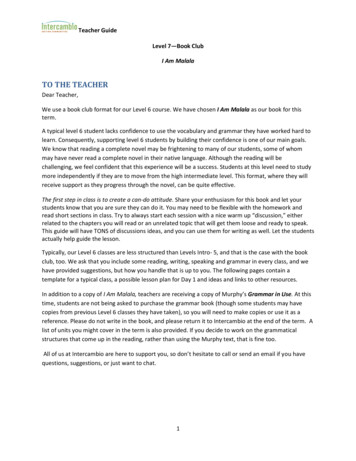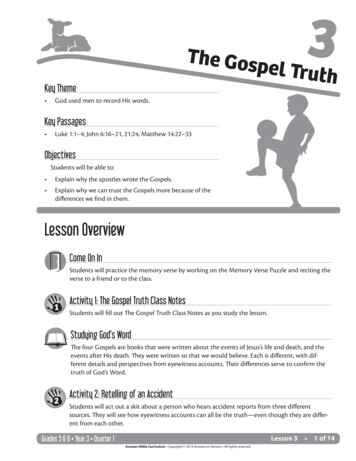
Transcription
The Gospel TruthKey Theme 3God used men to record His words.Key Passages Luke 1:1–4; John 6:16–21, 21:24; Matthew 14:22–33ObjectivesStudents will be able to: Explain why the apostles wrote the Gospels. Explain why we can trust the Gospels more because of thedifferences we find in them.Lesson OverviewCome On InCOME ON IN1ACTIVITY 1Students will practice the memory verse by working on the Memory Verse Puzzle and reciting theverse to a friend or to the class.Activity 1: The Gospel Truth Class NotesStudents will fill out The Gospel Truth Class Notes as you study the lesson.Studying God’s WordSTUDYING THE WORD2ACTIVITY 2The four Gospels are books that were written about the events of Jesus’s life and death, and theevents after His death. They were written so that we would believe. Each is different, with different details and perspectives from eyewitness accounts. Their differences serve to confirm thetruth of God’s Word.Activity 2: Retelling of an AccidentStudents will act out a skit about a person who hears accident reports from three differentsources. They will see how eyewitness accounts can all be the truth—even though they are different from each other.Grades 5 & 6 Year 3 Quarter 1 Lesson 3 1 of 14Answers Bible Curriculum Copyright 2014 Answers in Genesis All rights reserved.
Lesson PreparationWHAT YOU WILL DOWHAT YOU WILL NEEDCOME ON INCOME ON IN1ACTIVITY 1Print one Memory Verse Puzzle from the Resource DVD-ROM for each student.Memory Verse PosterMemory Verse Puzzle for each studentTHE GOSPEL TRUTH CLASS NOTESPrint, collate, and staple the two pages of TheGospel Truth Class Notes from the ResourceDVD-ROM for each student. Keep the answerkey for your use.The Gospel Truth Class Notes collated andstapled for each studentThe Gospel Truth Class Notes Answer KeyPencilsSTUDYING GOD’S WORDStudy the Prepare to Share section.STUDYING THE WORD2ACTIVITY 2Student Take Home SheetsGo Before the Throne.RETELLING OF AN ACCIDENTPrint four Retelling of an Accident Scripts fromthe Resource DVD-ROM.Four Retelling of an Accident ScriptsOptional props: chair, TV, remote, newspaperMemory VerseMEMORY VERSEJohn 1:14 And the Word became flesh and dwelt among us, and we beheld His glory, the glory as of theonly begotten of the Father, full of grace and truth. Pace your lesson! Use the clocks to mark the time you want to finish each section. This willhelp you stay on track and finish on time. You may need to shorten or drop sectionsas necessary.10:302 of 14 Lesson 3 Grades 5 & 6 Year 3 Quarter 1Answers Bible Curriculum Copyright 2014 Answers in Genesis All rights reserved.
Prepare to SharePREPARE TO SHARESCRIPTURAL BACKGROUNDPrepare to teach by preparing your heart. Read thekey passages listed above with this background.God has been pleased to give us the gospel, meaning “good news,” of the birth, life, death, and Resurrection of Jesus Christ for the redemption of sinners.This news is found in the four books we know as theGospels—Matthew, Mark, Luke, and John.We know that all Scripture is given by the inspiration of God (2 Timothy 3:16). And God in His infinitewisdom ordained the Gospels to be written by men.Through Luke, God was pleased to set in order a narrative of the things seen in Christ and His life. Lukerecorded his testimony from eyewitnesses and ministers of the Word so followers of Christ would know thatwhat is heard about Jesus is certainly true (Luke 1:1–4).Similarly, John stated that he wrote his Gospel accountso the reader may believe that Jesus is the Christ, theSon of God, and that believing he may have life in Hisname (John 20:31).As we study the four Gospels, we find that they arenot identical in content or style. In fact, each is uniqueto the man who penned it. Consequently, each Gospel isfocused on different details of Christ’s life. For example,each of the Gospels begins at a different point in the lifeof Jesus, and they each end in a slightly different way.However, the three Gospels of Matthew, Mark,and Luke are similar in that they record the same basicevents—although not all three men recorded eachevent in exactly the same way. These books are referredto as the synoptic gospels because they often take thesame point of view.The Gospel of John is very different from the otherthree. John included information not recorded in Matthew, Mark, and Luke. Jesus’s early ministry in John 2–4and the account of Jesus raising Lazarus in John 11 areexamples of events recorded exclusively by John. Johnalso left certain events out of his work that the otherGospels did document. Some of the accounts John leftout include the temptation of Jesus in the wilderness,the Sermon on the Mount, and the narrative parables.All four Gospels primarily focus on the three yearsof Jesus’s public ministry and largely skip over the earlyyears of His life. We have very little information aboutthe early years apart from the birth narratives in Matthew and Luke and the trip to Jerusalem in Luke 2.After that, all of the writers jump forward to the timewhen Jesus was about 30 years old and entered intoHis formal ministry.Many Bibles have headings indicating referencesto the same account in the other Gospels. For example,in the New King James Version being used to write thisbackground, the account of the feeding of the 5,000is recorded first in Matthew 14:13–21. The Bible hasa heading at that reference where this account can befound in the books of Mark, Luke, and John. Understanding how your Bible cross-references passages canhelp as you continue your study of the full counsel ofGod’s Word.Each of the Gospels reveals something uniqueabout the life of Jesus Christ. The entire picture cannotbe seen without seeing all four Gospels presented sideby side. This is called a “harmony” of the Gospels. YourBible may have a section or a chart—a harmony of theGospels—that shows the events of Jesus’s life and wherethose events are recorded in each of the Gospels.The Gospels are another example of God’s amazing revelation to His people. That these four uniquemen could each write a personal account of his SaviorJesus Christ, and that all four of these accounts wouldcomplement each other, is evidence of the inspirationof their writings through the Holy Spirit to present toHis people a complete and perfect testimony.HISTORICAL/APOLOGETICSBACKGROUNDMany skeptics point to the apparent inconsistencies in the parallel accounts in the Gospels to suggestthat the Holy Spirit could not have inspired the writingsor else they would be exactly the same. Well, how dothey know that is the case? To make that assertion, theyhave to know how God thinks and how He would dothings—the very thing they are denying we can knowby reading the Bible. This attempt by the skeptic to discredit the authority of the Bible is simultaneously anelevation of man’s word above God’s Word as he sits injudgment over what God has revealed to us.Stop and think about this for a moment: If you hearda news report of a car accident on the TV news, readabout it in the newspaper, and then heard about it froma friend who witnessed it, would you expect the threeaccounts to be exactly the same? Would differencescause you to doubt the truthfulness of any one witness?For example, if one report said it happened in front ofTaco Town and another said it happened across thestreet from the mall and your friend said it was on ThirdStreet, would that mean there was a contradiction? Notat all if Taco Town is on Third Street right across the streetGrades 5 & 6 Year 3 Quarter 1 Lesson 3 3 of 14Answers Bible Curriculum Copyright 2014 Answers in Genesis All rights reserved.
from the mall. This is analogous to the subtle differenceswe see in the Gospels. These subtle differences actuallyhelp to corroborate the truthfulness of the accounts. Ifa police officer was investigating the accident and twowitnesses told about the collision in exactly the samewords, he would likely think they were working togetherto conceal something. Matthew and Mark didn’t havea meeting to decide how to tell the same story—theHoly Spirit directed their writing. When we examine thebooks carefully, the apparent contradictions disappear,despite the claims of the skeptics whose hearts are hardened to the truths of God.Another irony of those who are skeptical about thetruthfulness of the Gospels is the number of witnesses.Four witnesses recorded the same basic information ofthe life of Jesus, and we have reliable records of theirinitial reports. From the biblical perspective, a matteris established on the word of two or three witnesses,so the four we have in the Gospels is more than sufficient to lead us to trust what they record (Deuteronomy19:15; Matthew 18:16). No one else from Jesus’s timehas such a rich historical record as that of Jesus. Andno one could because it was God the Holy Spirit whodirected the recording of the earthly life of God the Sonwho was sent by God the Father.It did not take long for false gospels to appear andcause confusion about what was true and what wasfalse (2 Peter 2:1). Many writers tried to take portions ofthe real Gospels and blend them with mystical teachings. These mystical ideas developed into what we callGnosticism. Some of these false gospels have beenpopularized in movies, novels, and documentary-stylefilms that seek to discredit Jesus as God or redefine Histeaching and work in some blasphemous way. Otherfalse gospels blended Jewish and Christian ideas, andothers tried to fill in the “gaps” of the true Gospels.One such false gospel, The Infancy Gospel ofThomas, was written more than 100 years after Jesusdied. This gospel reveals a young Jesus who was aninfant prodigy, performed miracles, breathed life intoclay birds, cursed a boy who then died, healed a man’sfoot, and other acts. These ideas directly contradict thetrue nature of Jesus we see recorded at the direction ofthe Holy Spirit in the Scriptures.Matthew, Mark, Luke, and John were directed bythe Holy Spirit to record the life and ministry of JesusChrist. And through God’s providence, we have thetruth of those accounts in the first four books of ourNew Testament. We can absolutely trust these as trueregardless of the attacks that come from skeptics andregardless of the doubts that may even arise in ourown minds. As we study the Scriptures, asking theHoly Spirit for wisdom, we can know the truth and beemboldened to share that truth with others.BEFORE THE THRONEBEFORE THE THRONEPrecious Lord, thank you for your Word and thetruth of it. My understanding of how you putthe Gospels together has grown. You have perfectly woven the truth about Jesus into thesefour Gospels through imperfect men who wereeyewitnesses to the accounts they have writtenabout—under the inspiration of the Holy Spirit.As you open my eyes to the truth of this Word, Irealize that it was written so that I would believe!May my students walk away from this lesson withmore confidence in your Word—that it is the true,inspired Word of God by which men can be saved!And may they one day believe all that is written init. To you be all the glory, Lord!4 of 14 Lesson 3 Grades 5 & 6 Year 3 Quarter 1Answers Bible Curriculum Copyright 2014 Answers in Genesis All rights reserved.
REVIEWCOME ON INCOME ON INREVIEWAs students arrive . . . They will review the memory verse bycompleting the Memory Verse Puzzle usingthe puzzle piece shapes as clues. If timeallows, they will recite the verse to a friend orto the class.This time at the beginning of class should be used to reviewthe memory verse. We have provided a worksheet on theResource DVD-ROM for you to use. You may have other ideasand ways to encourage your students to memorize the verse.1Using the Lesson Theme Posters provided witheach lesson, quickly review the previous lesson(s)with your students. Take 5 to 10 minutes toreinforce the important truths the students haveheard so far in your class.Ask the children questions about the previouslessons as you display the Lesson Theme Posters.Reflect briefly on the passages you read, bringingthe objectives and themes back into focus. Thiswill refresh the truths in your students’ mindsand maintain continuity asyou teach through the lessons.The Gospel Truth Class NotesACTIVITY 1MATERIALSCONNECT TO THE TRUTHThe Gospel Truth Class Notes (2 pages collated andstapled) for each studentThe Gospel Truth Class Notes Answer KeyPencilsINSTRUCTIONSPrint the class notes for each student. Pass them out at thebeginning of class. Have students fill in the blanks as youstudy the lesson.We are going to read about one biblicalevent written by two different apostles andcompare them. And we will understandbetter how the differences in the Gospelaccounts can actually help us believe theBible is true.As we compare the Gospels on our classnotes today, we will see that even thoughthe men were inspired by the Holy Spiritto write exactly what God wanted themto write and were eyewitnesses who knewJesus, or friends of eyewitnesses, theysometimes recorded differently whathappened. All the Gospels are God’s trueWord.They were written so that we would believe.Each Gospel shows us different thingsabout Jesus. We will see why we can trustthese Gospels because of the differences.The differences actually serve to confirmthe truth of God’s Word.Grades 5 & 6 Year 3 Quarter 1 Lesson 3 5 of 14Answers Bible Curriculum Copyright 2014 Answers in Genesis All rights reserved.
Use theNew TestamentHistory Posterincluded with yourteacher kit as youteach the lesson.Emphasize thatJesus ministeredonly 3 years andHe lived only about35 years. Yet His lifechanged the worldforever and broughteternal life to all whobelieve.Studying God’s WordSTUDYING THE WORDREAD THE WORDour lesson is about the first four books of the New Testament. Doesüü Todayanyone know what the first book of the New Testament is?üü And the second?üü And the third?üü And the fourth?Mark, Luke, and John. These four books have a special name.üü Matthew,Does anyone know what these books are called sometimes?Matthew.Mark.Luke.John.Allowdiscussion. Gospels.Yes. These four books are often called the Gospels.In the last lesson we said we could trust the New Testament to be true.üü What did we talk about?Refer to the Lesson 2 Lesson Theme Poster. Who can tell me why we can trust it?Allow discussion.Jesus promised the Holy Spirit would come and help His disciples to remember the things that happened—the things God wanted them to write.And these writers of the New Testament were eyewitnesses of the events,or friends of eyewitnesses, in the case of Mark and Luke.One of those writers was Luke. He wrote the Gospel of Luke. He wrotedifferently from the other Gospel writers—but he wrote the truth. Let’ssee what Luke had to say about Jesus. Turn to Luke1:1–4 in your Bibles.We’ll begin reading there. Choose students to read the verses.Luke 1:1–4EXAMINE THE WORDThose verses tell us a lot. Let’s answer questions about them so that wecan understand them better.Observe the TextNarrative: Anarrative isan accountof whathappened.üü First look at Luke 1:1. Luke mentions a “narrative.” What is that?Allowdiscussion.Luke was telling us that he wanted to set down in an orderly way anaccount of what happened in Jesus’s life.üü But how did Luke know what to write? Look at what it says in verse 2.Luke1:2. Allow discussion. He learned them from eyewitness.Yes. Luke gathered his information from those who were eyewitnesses.Many of these eyewitnesses were the apostles who had walked with Jesus6 of 14 Lesson 3 Grades 5 & 6 Year 3 Quarter 1Answers Bible Curriculum Copyright 2014 Answers in Genesis All rights reserved.
and learned much from Him personally. They told Luke what happened,and he wrote this Gospel under the inspiration of the Holy Spirit.üü So why did Luke write these things down?Re-read Luke 1:4. Allow discussion. Sopeople would know what happened and know it was true.Luke wrote these things so that believers in Jesus Christ could know thatwhat they heard about Jesus was true.Now let’s turn to another one of the Gospels. The Gospel of John waswritten by the Apostle John. He was one of Jesus’s very closest friends.Turn in your Bibles to John 21:24. Will someone read that? Choose a student toJohn 21:24read the verse.is the disciple this verse talks about? I’ll give you a hint. It’s the oneüü Whowho wrote the book of John!John.Yes. This is what the Apostle John wrote. Remember, he was one of Jesus’svery closest friends. He spent a lot of time with Jesus.üü And what does this verse say about John?John said he testified of “these things” what does he mean? Whatüü Whenthings? What do you think?He testifies of these things. He wrotethese things.Allow discussion.John wrote about Jesus. He wrote about His life, His death, and HisResurrection. He was an eyewitness of Jesus’s life, death, and Resurrection.And he told us what Jesus taught as He lived and walked on earth. Thisis all very important stuff. And we need to take notice. Jesus is the Savior.What He said and did are very important.did John especially want us to know about his testimony? It is at theüü Whatend of this verse.That his testimony is true.Discover the TruthWe just looked at some verses from two of the Gospels in the Bible—Lukeand John. They both wrote about the life of Jesus. They both were verycareful to write down what had been seen and heard about Jesus. Theywrote all these things down because they wanted us to know about Jesus’slife, His death, and the events that occurred after He died. The things theywrote were true. The books of Luke and John that we have in our Biblestoday are the very books that these two men wrote nearly 2,000 years ago.Refer to the New Testament History Poster. Take a look at our New Testament HistoryPoster. All the Gospels were written very soon after Jesus’s life while theeyewitnesses were still alive. The testimonies were accurate, but because theGospels were written by different men, what they wrotedown was not exactly the same. Let’s explore that a little.Grades 5 & 6 Year 3 Quarter 1 Lesson 3 7 of 14Answers Bible Curriculum Copyright 2014 Answers in Genesis All rights reserved.
READ THE WORDWe know the Bible is true! It was written by people who knew Jesusand knew His friends. But sometimes what we read in one Gospel is notexactly like what we read in another Gospel. Some people get confusedabout this, but it isn’t confusing or hard to explain. Let me show you whatI mean. We are going to read and outline two events from the Bible.First we will read Matthew 14:22–23. It is on Page 1 of your class notes.After we read it, we’ll go back and answer the questions on that page.Matthew 14:22–33 You can followthe Teacher Guidebelow or use theclass notes to readthe text. Completestatements 1–10 onthe class notes asyou read. The classnotes statementsalign with thequestions below.Choose students to read the verses.EXAMINE THE WORDThese verses reveal a dramatic account in the lives of Jesus and the disciples.Observe the Textüü What did Jesus do in Matthew 14:22—#1 on your class notes?üü What did Jesus do then—#2 on your class notes?üü What did Jesus do after He sent the people away— 3 on your class notes?üü Where was the boat—#4 on your class notes?üü What was happening to the boat—#5 on your class notes?üü What did Jesus do—#6 on your class notes?üü What did the disciples think about this—#7 and #8 on your class notes?üü What did Jesus say to them —#9 on your class notes?üü What did Peter ask Jesus—#10 on your class notes?He made Hisdisciples get into the boat.Matthew 14:22. He sent themultitudes (people) away.#Matthew 14:23. He went up on the mountain by Himself to pray.Matthew 14:24. In the middle of thesea.Matthew 14:24. Itwas being tossed by the waves and wind.Matthew 14:25. Jesus went to them,walking on the sea.Matthew 14:26. They thought He was a ghost. They were afraid.Matthew 14:27. Be of goodcheer! It is I; do not be afraid.Matthew 14:28. Lord,command me to come to you on the water.Peter wanted to walk out on the water to be with Jesus. And Jesus saidto Peter, “Come!” Peter left the boat and was walking on the water. ButPeter looked around and saw the waves and that the wind was blowing!And suddenly he started to sink! Peter cried out, “Lord, save me!” AndJesus grabbed Peter’s hand and brought him into the boat. When they gotinto the boat the wind stopped blowing! This was an exciting evening forJesus’s disciples.8 of 14 Lesson 3 Grades 5 & 6 Year 3 Quarter 1Answers Bible Curriculum Copyright 2014 Answers in Genesis All rights reserved.
OK. Good. That was Matthew’s account. There were a lot of details. Nowlet’s go to John’s account. Look on Page 2 of your class notes.is the first thing you notice as you compare what Matthew wrote toüü Whatwhat John wrote?version is shorter. That leads me to believe he didn’t include as muchüü John’sdetail. Let’s read it.üü What did the disciples do—#11 on your class notes?üü Where were the disciples going—#12 on your class notes?üü Was Jesus with them—#13 on your class notes?üü What happened in John 6:18—#14 on your class notes?üü How far had the disciples rowed—#15 on your class notes?üü What did the disciples see—#16 on your class notes?üü How did the disciples feel—#17 on your class notes?üü Who did they see? What did He say to them—#18 on your class notes?üü What happened next—#19 and #20 on your class notes?Allow discussion. John’s version is shorter.John 6:16–21John 6:16–21. Choose students to read the verses from the class notes.John 6:16–17. Went to thesea. Got in the boat.John 6:17.Capernaum.John 6:17. No. They were alone.The sea rose because ofa great wind.John 6:19. About 3or 4 miles.John 6:19. They saw Jesuswalking on the water. Again, youcan follow theTeacher Guidebelow, or use theclass notes to readthe text. Completestatements 11–20on the class notes asyou read. The classnotes statementsalign with thequestions below.John 6:19. They were afraid.John 6:20. They saw Jesus. He said, “Do not be afraid.”John 6:21. Jesus got inthe boat and the boat landed.Another exciting night. But not exactly the same as what we read inMatthew.Discover the Truthüü Do you think these two accounts are talking about the same event?Allowdiscussion.There are a lot of things that are alike in these two accounts, enough thatwe know it is the same account about the same stormy night. But theyare different too, aren’t they? Well, let me explain.üü Who wrote these two accounts?üüMatthew and John.Right. Two different men wrote about the same night.Who gave us more information about the stormy night? Matthew.Yes. Matthew tells us a lot more. Matthew tells us that Jesus told themto get in the boat, that Jesus sent the crowds away, that Jesus went upon the mountain to pray, and even what time it was when Jesus walkedon the water. And Matthew tells us all about Peter’s attempt to walk onGrades 5 & 6 Year 3 Quarter 1 As you discussthese points, referto the verses on theclass notes.Lesson 3 9 of 14Answers Bible Curriculum Copyright 2014 Answers in Genesis All rights reserved.
the water—how he reacted, and how Jesus saved him. Peter started tosink. Peter spoke to the Lord. Peter wanted Jesus to save him. Peter criedout to the Lord. And the Lord caught Peter and then they got into theboat. Matthew even tells us what Jesus said to Peter as He saved him.And Matthew tells us that when Jesus and Peter got in the boat the windstopped. John didn’t mention any of that!John tells us much less. But he does include some things Matthew didnot. He tells us that the disciples were headed to Capernaum, and thatthe disciples had been rowing for three or four miles when they saw Jesus.John mentioned that Jesus was not with them, but unlike Matthew, hedoesn’t tell us that Jesus went up to the mountain to pray. And John saidnothing about Peter walking on the water and almost drowning!Do you see? These two books, Matthew and John, were written by twodifferent men. Each man reported what he thought was important aboutthe stormy night when Jesus walked on the water. It makes sense thatwhat they wrote would not be exactly the same. But when we put theaccounts together we get a better understanding of EVERYTHING thathappened. There is nothing in these accounts that contradicts the other;they are just from two different perspectives.People want to say that the differences in the Gospels prove that the Bibleis not true. But actually those differences give us confidence that it IS true.Let me explain. Those differences show that different people wrote theBible at different times. And because of that it makes sense that many ofthe events don’t appear exactly the same in the Bible. If people hadwanted to write the Bible to fool people with made-up stories, theywould have been careful to get all the details the same. Instead, theyreported actual eyewitness accounts, with differences like we’d expect tofind. But at the same time, the events are similarenough so that we can be sure they are the same eventand they are true!10 of 14 Lesson 3 Grades 5 & 6 Year 3 Quarter 1Answers Bible Curriculum Copyright 2014 Answers in Genesis All rights reserved.
2Retelling of an AccidentACTIVITY 2MATERIALSFour Retelling of an Accident Scripts from the ResourceDVD-ROMOptional props: chair, box with a hole cut in it to serve asa “screen” for the newscaster, remote, newspaperINSTRUCTIONSAssign three students to play the characters. Encourage theactors to speak up and play their roles with enthusiasm.This fun skit may help you understand howpeople can witness the same event yetdescribe it differently. It’s a modern-dayexample of what it is like to hear aboutsomething from three different sources.Pay attention to what is similar and what isdifferent. Have students perform the short skit.CONNECT TO THE TRUTHThe first time Jason heard about the carcrash was on TV when the newscaster saidit happened near Taco Town. The secondtime he heard about the accident was inthe newspaper article.did the paper say the accidentüü Wherehappened?On Third Street.Yes, on Third Street. And when his friendcame over he said the accident was by themall.üü Which one was right?They all were.things were the same in the differentüü Whatversions?Allow discussion. SUV rolled, two girls stuckinside, the jaws of life.Even though all the accounts were told in adifferent way based on what the witnessessaw, there were enough details that were thesame. As Jason read and heard each of thethree accounts, he knew they were the same.The newscaster didn’t mention who it wasor if the children were taken to the hospital.The newspaper said the accident was onThird Street. Someone called 911. Themother was panicked. The airbags deployed.Jason’s friend knew who it was and whathappened to them. He knew someonewas in the hospital, but he didn’t mentionthe dog. And he didn’t know some of theother details.The three accounts of the accident weredifferent. But that doesn’t mean the peoplewere lying or that the event didn’t happen.It made the event seem even more realbecause witnesses see things differently.It is the same with the four Gospels. Fourdifferent men wrote the accounts, and theyeach told what they thought was importantabout Jesus’s life. What is really neat is thatGod worked it in just a way that when weread all four Gospels, we find out everythingGod wanted us to knowabout Jesus’s life!Grades 5 & 6 Year 3 Quarter 1 Lesson 3 11 of 14Answers Bible Curriculum Copyright 2014 Answers in Genesis All rights reserved.
Applying God’s WordAPPLY THE WORDWHAT YOU HEARD IN THE WORDThe Gospels were written to tell about Jesus and His life on earth sothat we would believe in Him. They tell us about His special birth, Hislife, and His death, and even what He did after He died. Matthew, Mark,Luke, and John wrote the Gospels. Today we looked at some verses fromMatthew and John—two of the Gospels. Both men were very careful towrite down what witnesses saw and heard about Jesus. And they wrote allthose things down because they wanted us to know about Jesus’s life andbelieve in Him.We saw in two accounts of Jesus walking on the water that Matthewand John each had some different things to say. We know that they weretalking about the same stormy night. They just each wrote about differentthings and different details. These Gospels were written by two differenteyewitnesses. And they would not have seen, heard, or experiencedeverything exactly the same. That is why some of the details are different.Those differences shouldn’t make us doubt the Bible. In fact, thosedifferences confirm that the Bible is true! It confirms that different peoplewrote the Bible, and that those people were writing about the samethings—things that really did happen!GOD’S WORD IN THE REAL WORLDSome people have doubts about the truth of the Gospels. They say ifthe Holy Spirit really inspired the men who wrote the Gospels, then allof them should say the same thing. We’ve already talked a lot abouteyewitnesses and how they will report the same thing differently.In fact, if everyone that witnesses an event described the details exactlythe same, it would seem fake. Did you know that when police detectivesquestion the witnesses of a crime, they will doubt the testimony of twopeople if they tell the exact same story?12 of 14 Lesson 3 Grades 5 & 6 Year 3 Quarter 1Answers Bible Curriculum Copyright 2014 Answers in Genesis All rights reserved.
It’s because two people giving the exact same testimony about somethingis not realistic. It usually means that the people got together to agree ona fake story before talking to the police. So, again, I’ll remind you that thedifferences in the Gospels show that they are true.Now I want you to consider something else. When someone says thatbecause the Gospels are different, they can’t be true, that person is notjust questioning the Gospels. He
Each of the Gospels reveals something unique about the life of Jesus Christ. The entire picture cannot be seen without seeing all four Gospels presented side by side. This is called a "harmony" of the Gospels. Your Bible may have a section or a chart—a harmony of the Gospels—that shows the events of Jesus's life and where

